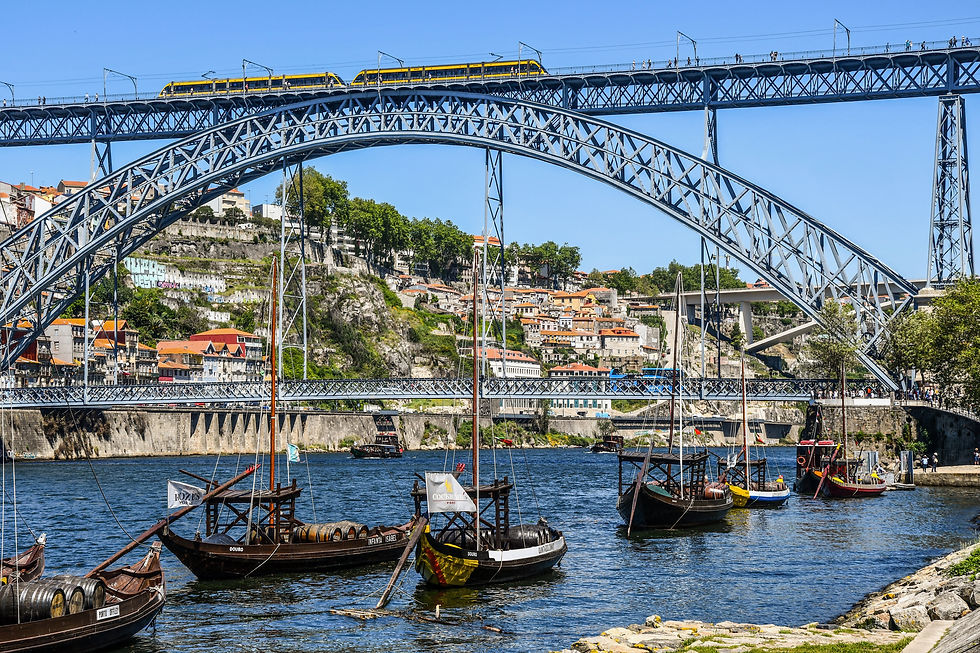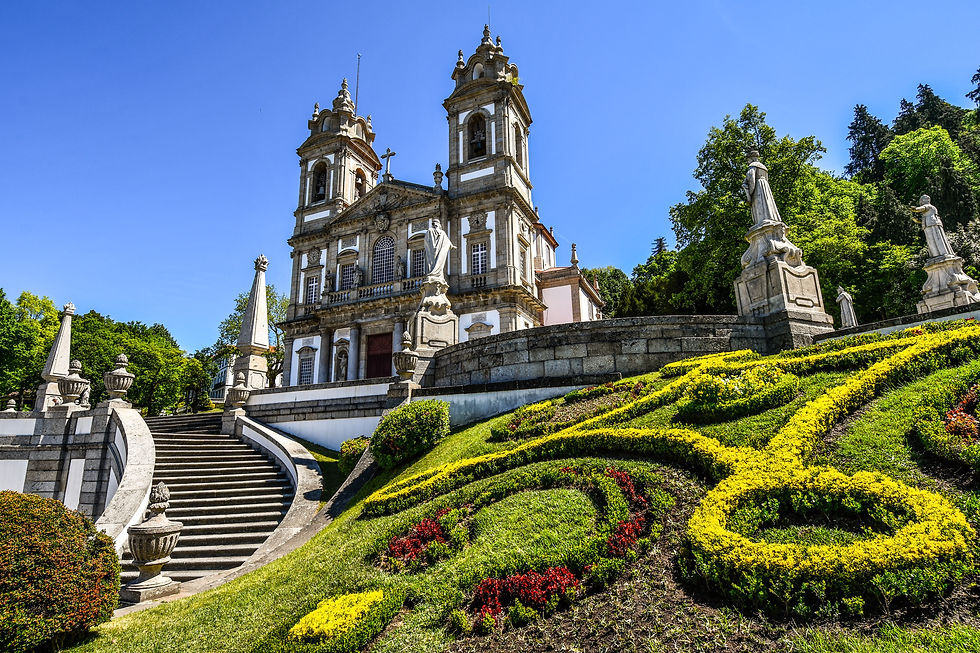One of the oldest cities in Europe on the estuary of Duoro River, Porto is colorful, rich with history, cool neighborhoods with cobbled narrow streets, and surrounded by beauty, charming towns, and the most scenic vineyards in the world.

Ribeira
Enchanting riverside district lined with colorful row houses, tapas bars, and cafés—Ribeira is one of the oldest and most popular neighborhoods rising over the Douro River with winding narrow cobbled stone streets. Besides the spectacular river views of the Ponte Dom Luis I Bridge and landmark Palácio da Bolsa neoclassical architecture—the area is wonderful and designated a UNESCO World Heritage Site.

Miragaia
Strolling past the city walls is the charming riverside neighborhood of Miragaia. Once a medieval shipyard and the Jewish and Armenian quarter—Miragaia is a wonderful area to enjoy quieter walks and smaller eateries.
If the colorful rowhouses weren't enough, Porto has over 80 public art projects to enjoy. "Miragaia" by stencil artist Daniel Eime depicts a local resident—the popular "Perspéntico" by Liqen, a big blue cat carrying buildings on its back in a narrow alleyway—"Half Rabbit" made of recycled material by Portuguese artist Bordallo wraps a corner of a building—and "Look at Porto" by Vhils features a face sculpted out from a building facade are a few notable murals.

Bolsa Palace - Palácio da Bolsa
Alongside the Church of Saint Francis of Porto in the historical Henrique Square—Bolsa Palace was once part of the St Francis Convent founded in the 13th century—during the Liberal Wars the cloisters were destroyed and Queen Mary II donated the ruins to the merchants of the city who built the seat of the Commercial Association.
In 1842 the Stock Exchange Palace was created—the Neoclassical style Palace influenced by Palladian and Venetian style architecture using symmetry, perspective, and values of classic temple architecture of the Ancient Greeks and Romans. The interior of the Palace finished in 1910 is magnificent—the Nations’ Courtyard with octagonal glass panels decorated with painted coats-of-arms of Portugal and trading partners. A sumptuous staircase covered with ceiling frescoes is adorned with sculptures and busts leading to several rooms—Tribunal, Golden, and Assembly featuring many works of art—including allegoric paintings by José Maria Veloso Salgado and João Marques de Oliveira, sculptures by Teixeira Lopes.

Arab Room
The jewel of the Palace is the ornate Arab Room decorated in exotic Moorish Revival style was inspired by the Palace of Alhambra in Granada, Spain. Design by Gustavo Adolfo Goncalves e Sousa the room is magnificent and used as a reception hall for heads of state visiting Porto.

Igreja de São Francisco
Gothic-inspired exterior with stunning Baroque interiors—Church of Saint Francis began in 1383 under the patronage of King Ferdinand I and completed in 1425 features elaborate rose window, two tiers Solomonic columns with the statue of St Francis.
Upon entering a statue of Saint Francis of Assisi greets visitors—the inner altarpiece, ceiling, and columns are covered with stunning Portuguese gilt woodwork. The center altarpiece depicts “Tree of Jesse” who was the father of King David—and describes the metaphorical descent of the Messiah, Jesus Christ.
Under the church are the catacombs where the Franciscan monks are buried and ossuary with the remains.

Azulejo
The colorful Portuguese painted tin-glazed ceramic tilework is seen throughout the city on chapels, churches, palaces, and even ordinary buildings and homes. The traditional ornamental art is derived from the Arabic al-zillīj, meaning polished stone used on Byzantine and Roman mosaics. Beautiful examples can be found at São Bento Train Station, Igreja de Santo Ildefonso, and Pinhão Train Station.

Ponte de Dom Luís I
Spanning the River Douro— Ponte de Dom Luís I is a double-deck metal arch bridge connecting the granite river banks of Ribeira with Vila Nova de Gaia known for tasting rooms and cellars where port wine is stored and aged. The upper sections connect with Avenida Vímara Peres and Monastery of Serra do Pilar with specular views.

Vila Nova de Gaia
Simply known as Gaia—the small fishing village of Afurada is the center of the Port wine industry. Since the 17th-century barrels of wine traveled down the River Douro from the Douro Valley and stored in the many port cellars along the granite riverbank lined with tasting rooms, cafes, and quaint seafood restaurants and markets. It is one of the most popular designations and great to relax in the sun and enjoy ruby, white, tawny or vintage ports from a variety of producers—Sandeman, Burmester, Taylor’s, Quinta do Noval and Fonseca wine cellars are just a few to enjoy and familiarize with the different vintages.

Douro Valley
Vine, valley, and wonder of nature—the Douro Valley is known for its famous Port wine, and scenic vineyards on vertical hilltop terraces with spectacular views will fascinate both wine and landscape lovers. The Douro is the highest river on the Iberian Peninsula flowing from Duruelo de la Sierra in central Spain through a deep valley in northern Portugal to the sea. The traditional style wooden Rabelo boats are still used to transport wine to the cellars in Porto.
The town of Pinhão on the confluence of Douro and Pinhão rivers is a great stop for lunch, river cruises, and enjoy Port wine at Quinta da Foz or Quinta do Bomfim. In the town center is the 1937 Pinhão Train Station with azulejos mosaics depicting scenes of the valley and port wine production. Surrounding Pinhão is Sandman, Quinta do Tedo, and dozens of more vineyards.
The Douro Valley is breathtaking and days can be spent exploring the wine region—yet close enough to Porto to enjoy a few vineyards in a single day.

Sé do Porto
The oldest city monument perched on Penaventosa Hill surrounded by castellated walls gives the impression of fortification—Porto Cathedral flanked by two towers, flying buttresses crowned with cupola, Baroque porch, and Romanesque rose window took six centuries to build beginning in 1110 and completed 1737.
The predominantly Romanesque nave is decorated with marble stoups. gilded wood-carvings and magnificent baroque era silver altarpiece covered by barrel vaulting. The cloister wall is lined with exquisite azulejo tile depicting the Bible’s Songs of Solomon and Ovid’s Metamorphoses a Latin poem that chronicles the history of the world from creation to the deification of Julius Caesar—and Renaissance style staircase leading to the chapter house decorated coffered ceiling.
Surrounding Sé do Porto is the active neighborhood of Baixa home of many landmarks, including São Bento Railway Station with over 20,000 azulejo tile panels, dating from 1905-1916—and Lello Bookstore made famous from the magical world of Harry Potter.

Capela das Almas
A popular backdrop to Bilhao Market is the Chapel of Souls, the Baroque chapel famous for beautiful azulejo tile depicting the life of Saint Francis of Assisi and Saint Catherine, the patrons of the chapel. The chapel is also known as the Old Mother Chapel was renamed in the 15th century when King Afonso III was buried in the churchyard.

Igreja dos Carmelitas & Igreja do Carmo
Standing side-by-side the two churches styled in Baroque and Rococo appear as one are separated by a very narrow house built to prevent common walls and relationship between nuns and monks.
Igreja dos Carmelitas built in the 17th century features three arched entrances with images of Santa Teresa de Jesus, San Jose, and Nossa Senhora do Carmo—and azulejo-covered bell tower with a bulb-shaped dome. Igreja do Carmo is one of the most instagramical churches in Porto with an azulejo-covered exterior depicting scenes of the founding of the Carmelite Order and Mount Carmel.

Fundação de Serralves Museu de Arte Contemporânea (Contemporary Art Museum)
The Contemporary Art Museum designed by Portuguese architect, Álvaro Siza Vieira is the 2nd most visited museum in all of Portugal. The museum collections include over 4300 public and private works of art produced from the 1960s to the present day—and including works from Pedro Calapez, Fernando Calhau, Manuel Casimiro, and Lourdes Castro.
The museum surrounded by Serralves Park with beautiful sculpture gardens and Casa de Serralves, an Art Deco villa built by Count of Vizela is a unique example of Streamline Modern architecture. The garden and villa grounds are great for a leisure stroll and enjoy the arts.

Centro Português de Fotografia (Portuguese Center of Photography)
The 18th-century stately building once a courthouse and prison until dictator Antonio de Oliveira Salazar was deposed—now a center of culture and creativity the museum is dedicated to photography dating back from the earliest cameras to today's modern craft. The museum features both Portuguese and international photographers and their work exhibited along the old granite-covered prison walls.

Clérigos Church
One of the first Roman Baroque churches in Porto to adopt the elliptic floor plan—Clérigos Church with a facade decorated with motifs of garland and shells and monumental bell tower, the Torre dos Clérigos can bee seen throughout the city.
The church by Italian-born artist Nicolau Nasoni was one of the most influential Portuguese architects for his theatrical style using Baroque and Rococo architecture. Nasoni's contributions to architecture throughout Porto and Northern Portugal include Episcopal Palace, frescoes on the wall of the Porto Cathedral.

Guimarães
UNESCO World Heritage Site for being an exceptionally well-preserved example of a medieval settlement—and known as the “candle of the nation” for being the birthplace of the country's first king, Afonso Henriques.
The old town is full of wonder beginning with the magnificent Burgundian style Palace of the Dukes of Braganza and the iconic Castle of Guimarães dating to the 10th-century. Rua de Santa Maria lined with history connects the city hall to the castle—and traces its architectural roots to the 12th-century. Along the street, you’ll find the former monastery, Igreja de Nossa Senhora da Oliveira with cloisters and bell tower near the Gothic monument, Padrão do Salado marks the spot of the original olive tree used to supply oil for the Church’s altar lamp.
The heart of the city is the picturesque 17th-century Largo do Toural lined with cafes—Museu de Alberto Sampaio with over 2000 religious artifacts, and beautiful Nossa Senhora da Consolação e Santos Passos Church are also noteworthy stops.

Braga
Under the Roman Empire, Braga was known as Bracara Augusta and the capital of the province of Gallaecia. It hosts the Braga Cathedral and oldest Portuguese archdiocese dating to the 3rd century with several chapels including the Chapel of Piety, Glory, and Kings. The facade reflects Romanesque, Gothic, and Late Gothic styles—interiors Romanesque, Baroque, and Neoclassical styles—and geometrical tile motifs of Moorish influences and a beautiful renaissance tomb. The cathedral was the most important religious site in Iberia before the founding of Santiago of Compostela and an important stop of the Portuguese Way (Spiritual Journey) of the Road of St. James.
Other sites to visit are the old city gates, Arco da Porta Nova—the exquisite Garden of Santa Barbara along the medieval palace walls—Praca Da Republica is known as Arcada, a historic plaza with historic buildings, cathedrals, and cafes—and Bom Jesus do Monte, a pilgrimage site and city’s biggest attraction.

Bom Jesus do Monte
The hilltop shrine and church outside the city of Braga known as Good Jesus of the Mount with a monumental baroque-style staircase. With stunning views of the valley—pilgrims ascend 381-feet, traditionally on their knees withs scenes of the Passion of Christ and several fountains symbolizing the purification of the faithful.

Fortaleza de Valença
Scenic Baroque and Gothic military fortress overlooking the Minho River separating Portugal from Spain is known for medieval walls, narrow gates, watchtowers, restaurants, and shopping. Within the fortress are a series of small chapels, including the 13th-century Romanesque Church of Saint Estevão, 14th-century Church of Saint Estevão with Neoclassical facade, and the small Chapel of Good Jesus. The towers and battlements provide stunning scenic views of the river.
Northern Portugal is full of rich history, beautiful landscapes, colorful architecture, quaint towns, scenic vineyards, and amazing food to refresh your spirit and relax your soul—so get out and explore. Return for future posts on Great Coastal Escapes, Magnificent Florence, and much more. All prints are available — DM for more information.
Sources: Wikipedia
























